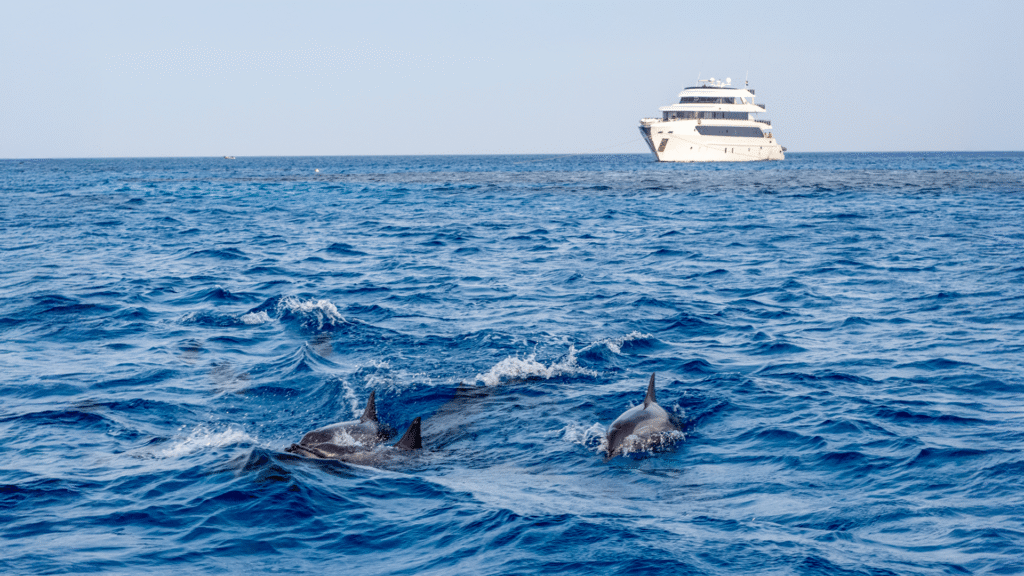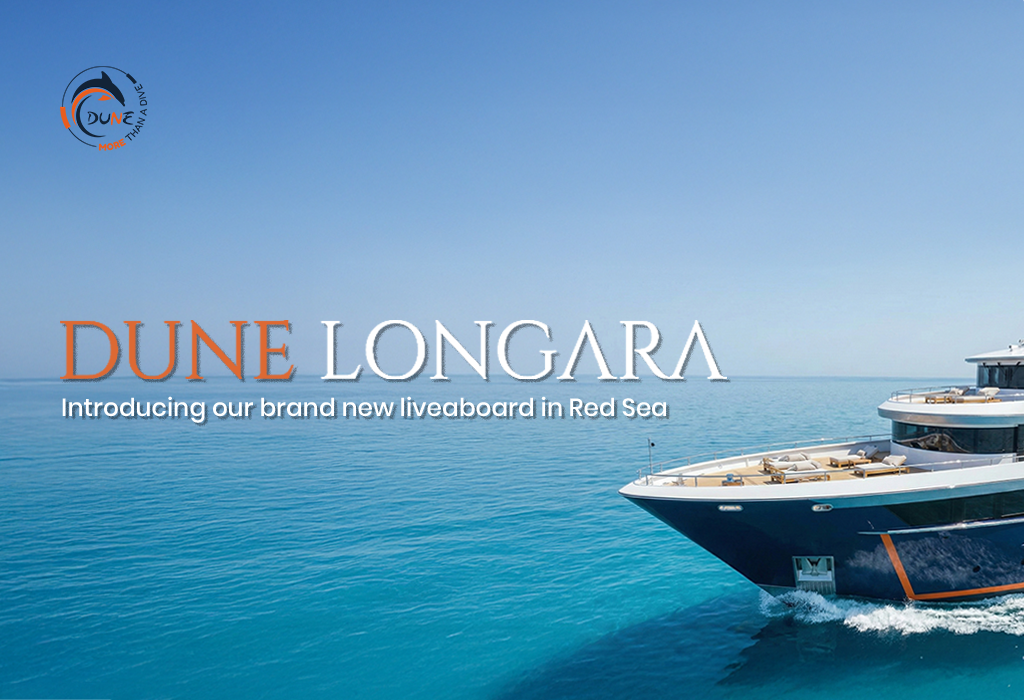
The Red Sea isn’t simply a spot on a map for divers; it’s a fantasy. Under its beautiful blue seas is a secret world full of old shipwrecks that tell silent stories, coral gardens that burst with colour, and moments with majestic sharks and rays that you’ll never forget.
You have to live in this underwater paradise to really immerse yourself in it. That’s what makes a liveaboard so special. You don’t simply visit the water; you live on it. You are taken to faraway diving sites, where you may dive as much as you like, and the water is your home. Imagine waking up every day to the smooth rocking of the boat and the thrill of not knowing what you’ll find below the surface.
Red Sea Liveaboard Diving will always amaze you, no matter how much you know about it. Maybe this is your first time looking inside the hold of a wreck, or maybe you’re just there to feel the currents at the Brothers Islands. Every dive gives you something absolutely exceptional, no matter what your aim is.
Why Diving on a Liveaboard in the Red Sea is a Must-Do
Red Sea underwater vistas range from lively shallow coral gardens to deep drop-offs full of aquatic life. Visibility exceeds 30 metres, and the temperature is comfortable at 22°C in winter and 28°C in summer. These circumstances allow year-round diving, with some months offering great aquatic excursions.
Every dive is enhanced by maritime history. Sunken ships from conflicts and old trade paths have become flourishing artificial reefs, creating a coral and marine life museum.
For the Beginner or Newer Diver
The “Wrecks & Reefs” courses in the northern Red Sea are great for novices since they are both fun and easy.
Best Itineraries: Expect to explore the world-famous SS Thistlegorm and Abu Nuhas Reef, both of which have depths and currents that are easy to handle and good for increasing confidence.
Main points: The SS Thistlegorm is 16 to 32 metres deep and is still in great shape, with bikes, trucks, and freight still visible. The “ship graveyard” Abu Nuhas has four wrecks near together, including Giannis D and Chrisoula K.
Things to Look For: Choose operators that welcome people at all ability levels and have experienced guides and rigors safety requirements.
Heads-Up: Some deeper locations, such Rosalie Moller (50 metres), need Advanced certification. Always check the criteria before making a reservation.
For the “Shark Hunter” Who Wants to Have Fun

The BDE route in the southern Red Sea—Brothers, Daedalus, and Elphinstone—has some of the best pelagic activity in the world for experienced divers.
Best Itineraries: Expect deep cliffs, powerful currents, and seas full of nutrients that draw in top predators.
Highlights: You can see oceanic whitetips, hammerheads, grey reef, and thresher sharks. At daybreak, Daedalus Reef is home to schools of hammerheads, while Elphinstone’s southern plateau is known for its oceanic whitetips. There are additional wrecks in the Brothers, including Aida and Numidia, which are covered in soft corals.
When to Go: Plan your vacation for the best times of year. Hammerheads are more prevalent in the summer, but whitetips can be seen all year. Pick operators who are familiar with the present conditions and know how to keep divers safe.
These are advanced places that need good buoyancy and confidence in open water.
For People Who Love Photography and Marine Life
Photographers are drawn to both the north and south Red Sea routes because they provide a wide range of themes.
Perfect Itineraries: The north is great for taking pictures of wrecks and macro photographs. The south is great for taking wide-angle pictures of sharks, mantas, and coral plateaus.
Capture schools of anthias, bright soft corals, and the eerie innards of wrecks like Thistlegorm’s freight holds. Clear waterways let you make dramatic silhouettes and light-play compositions.
What to Look For: Choose liveaboards that are equipped for cameras and have big tables, charging stations, and rinse tanks. Smaller groups on dedicated photo tours can spend more time at the bottom and have more flexible timetables.
The “Eat, Sleep, Dive, Repeat” Plan
On a normal day of diving on a liveaboard in the Red Sea, you may do three to four dives. The first one starts at sunrise and the last one ends at night.
The greatest time to see and do things is early in the morning. After breakfast, you’ll go for another dive and then rest on deck. Afternoon dives show off the reef’s golden light, while night dives show off the reef’s nighttime life.
Take a break between dives to rest, talk to people, and write down what you’ve done. Most itineraries make sure that there are safe surface intervals (12 to 16 hours overnight) to keep the nitrogen release at the right level.
On Board Life
Life on board is casual and social, with a blend of comfort, connection, and adventure.
People from all around the world can make friends over meals and free time in a communal setting. Shared areas like lounges and sun decks make it easier to talk and hang out with other people.
Limited Space: The cabins are small, so don’t bring too much stuff. Most operators give out packing lists to assist people pack the most important things and prevent clutter.
Movement Sickness: The weather can change, even though the Red Sea is usually calm. If you get seasick easily, bring medicine or natural cures like ginger.
The Experience That Includes Everything
Liveaboards are a great deal since they combine diving, eating, and sleeping into one smooth trip.
Cost Breakdown: The initial rates may appear costly, but they include meals, housing, unlimited dives, tanks, weights, and diving guides, which makes them cheaper per dive than day excursions.
What comes with it: You should have three meals a day, snacks, soft drinks, tanks, and weights. Many operators will provide you free basic gear and zodiac rides to diving locations.
Costs that aren’t obvious: Plan for the cost of flights, transportation, rental gear, drinks, marine park fees, and gratuities for the crew. Some itineraries additionally demand tiny extra fees for gasoline.
Safety and Logistics
The Red Sea liveaboard experience is all about being professional and ready.
Crew of Experts: Certified guides know a lot about the area, the weather, and how marine animals act. Captains change the itineraries according on the weather or sea conditions to make sure the dives are safe and fun.
Boats have first aid supplies, oxygen tanks, and radios. For extra protection, most operators also want to see confirmation of diving insurance.
Navigation: Liveaboards may move about depending on the weather, which is a big plus that keeps diving conditions good.
Certifications: Make sure that your training and documented dives match the route you want to go, especially for locations that are deep or have strong currents.
Benefits of a Liveaboard
- Access to dive spots that are far away and not too crowded
- The most time underwater with the least amount of trip
- A social experience that immerses you with other divers
- Comfort and convenience for everyone
Cons to Think About
- Less privacy and fewer living areas
- Getting ill while sailing or in stormy seas
- Set timetables with little time on land
Ready to Dive In?
Red Sea liveaboard diving combines adventure, discovery, and connection. Whether you’re exploring the historic Thistlegorm wreck or drifting alongside hammerheads at Daedalus, every dive tells a story of exploration and beauty.
With warm waters, crystal-clear visibility, and experienced crews, the Red Sea is an ideal destination for divers of all levels. To make your journey seamless, book your Red Sea adventure with Dune Liveaboard — a trusted agent known for its professional service, expert guides, and well-equipped vessels.
Compare itineraries, choose your perfect route, and take the plunge into a truly unforgettable diving experience with Dune Liveaboard.
FAQs About Red Sea Liveaboard Diving
What certification do I need for Red Sea diving?
Open Water certification suits northern routes and wreck dives. Southern itineraries like BDE usually require Advanced Open Water or 30+ logged dives due to depth and current.
Sure — here’s the shorter, concise version while keeping it natural and professional:
Is Red Sea Liveaboard Diving Safe? (FAQ)
Yes. Dune Liveaboard team consists of certified dive guides who follow strict global safety standards. Each trip includes detailed briefings, equipment checks, and reliable emergency procedures.
What can I expect for visibility and temperature?
Visibility often exceeds 30 metres, and temperatures range between 22°C and 28°C — perfect for diving year-round.





